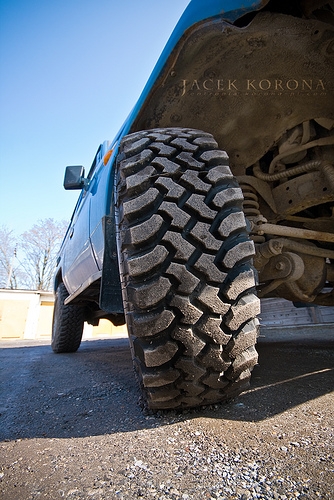
A car's constant velocity (CV) joints normally do their job of keeping the wheels rolling smoothly and securely for more than 100,000 miles. Damage to the protective boots that cover these joints, however, can lead to serious problems. A defective CV boot can let grease escape and grit enter, wrecking the metal surfaces inside the joint. These problems announce their arrival with knocking, growling or clunking noises when the car is in motion. While early stage damage may require only some new grease and a new boot, a worn-out joint will require replacement.
Samarins.com describes a CV joint as a joint attached to one end of a car's right or left drive shaft. This joint transfers the forces of the spinning shaft to the wheels at a constant rate, while adjusting to the up-and-down forces coming from the car's suspension. A "ball-type" outer CV joint attaches to the shaft at the wheel, while a "tripod-type" inner CV joint attaches to the shaft at the transmission. The CV joints are covered by rubber CV boots that protect the joints from grime while holding in the packed grease that keeps the joints moving smoothly.
A CV joint with an intact CV boot will usually perform for up to 150,000 miles before wearing out. According to AA1Car.com, however, many joints never make it to this point and require replacement somewhere between 70,000 and 130,000 miles. Repair shops replace approximately 10 million CV shafts every year. Certain makes of car, notably Subaru, have a reputation for going through shafts more quickly than usual.
Factors such as temperature extremes, road hazards or simple age can cause the boot covering the CV joint to loosen, tear or split, allowing dirt or water into the joint and damaging the finely tuned metal components. The joint will start to leak out the grease that lubricates these components, allowing for metal-on-metal friction and premature wear.
Spattered grease on or around the CV boot, or any visible damage to the boot or joint, indicates that the joint may need repair or replacement. The most obvious trouble signs while driving include noises or vibrations. Clicking noises during turns, clunking noises when changing gear, and growling noises all signal CV joint damage. A vibration in the car during acceleration may or may not indicate a bad joint. If the vibration increases steadily at higher speeds, the problem probably lies with the wheel or tire instead.
Inspecting the CV boots at regular intervals can help spot a potential problem early on. In such cases, replacing the boot and regreasing the cleaned CV joint can solve the problem. Unfortunately, by the time a CV joint makes its signature clicking or clunking noises, it has probably sustained damage, forcing a replacement of the CV joint. Technicians usually opt to replace the entire shaft rather than a single CV joint.